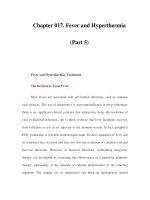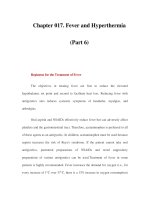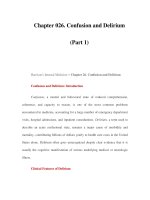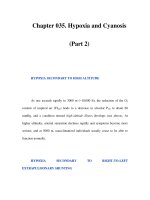Chapter 053. Eczema and Dermatitis (Part 6) pdf
Bạn đang xem bản rút gọn của tài liệu. Xem và tải ngay bản đầy đủ của tài liệu tại đây (13.72 KB, 5 trang )
Chapter 053. Eczema and
Dermatitis
(Part 6)
Psoriasis
(Table 53-2) Psoriasis is one of the most common dermatologic diseases,
affecting up to 1% of the world's population. It is a chronic inflammatory skin
disorder clinically characterized by erythematous, sharply demarcated papules and
rounded plaques, covered by silvery micaceous scale. The skin lesions of psoriasis
are variably pruritic. Traumatized areas often develop lesions of psoriasis
(Koebner or isomorphic phenomenon). Additionally, other external factors may
exacerbate psoriasis including infections, stress, and medications (lithium, beta
blockers, and antimalarials).
Table 53-2 Papulosquamous Disorders
Clinical
Features
Other
Notable
Features
Histologic
Features
Psoriasis Sharply
demarcated,
erythematous plaques
with mica-
like scale;
predominantly elbows,
knees, and scalp;
atypical forms may
localize to
intertriginous areas;
eruptive forms may be
associated with
infection
May be
aggravated by
certain drugs,
infection;
severe forms
seen associa
ted
with HIV
Acanthosis,
vascular
proliferation
Lichen planus Purple
polygonal papules
marked by severe
pruritus; lacy white
markings, especially
associated with
mucous membrane
lesions
Certain
drugs may
induce:
thiazides,
antimalarial
drugs
Interface
dermatitis
Pityriasis rosea
Rash often
preceded by herald
patch; oval to round
plaques with trailing
scale; most often
affects the trunk, and
eruption lines up in
skin folds giving a "fir
tree"-
like appearance;
generally spares palms
and soles
Variable
pruritus; self-
limited
resolving in 2–
8 weeks; may
be imitated by
secondary
syphilis
Pathologic
features often
nonspecific
Dermatophytosis
Polymorphous
appearance depending
on dermatophyte,
body site, and host
response; sharply
defined to ill-
demarcated scaly
plaques with or
without inflammation;
may be associated
with hair loss
KOH
preparation
may show
branching
hyphae; culture
helpful
Hyphae
and neutrophils in
stratum corneum
The most common variety of psoriasis is called plaque-type. Patients with
plaque-type psoriasis will have stable, slowly enlarging plaques, which remain
basically unchanged for long periods of time. The most commonly involved areas
are the elbows, knees, gluteal cleft, and the scalp. Involvement tends to be
symmetric. Plaque psoriasis generally develops slowly and runs an indolent
course. It rarely remits spontaneously. Inverse psoriasis affects the intertriginous
regions including the axilla, groin, submammary region, and navel; it also tends to
affect the scalp, palms, and soles. The individual lesions are sharply demarcated
plaques (see Fig. 52-7), but they may be moist and without scale due to their
location.









